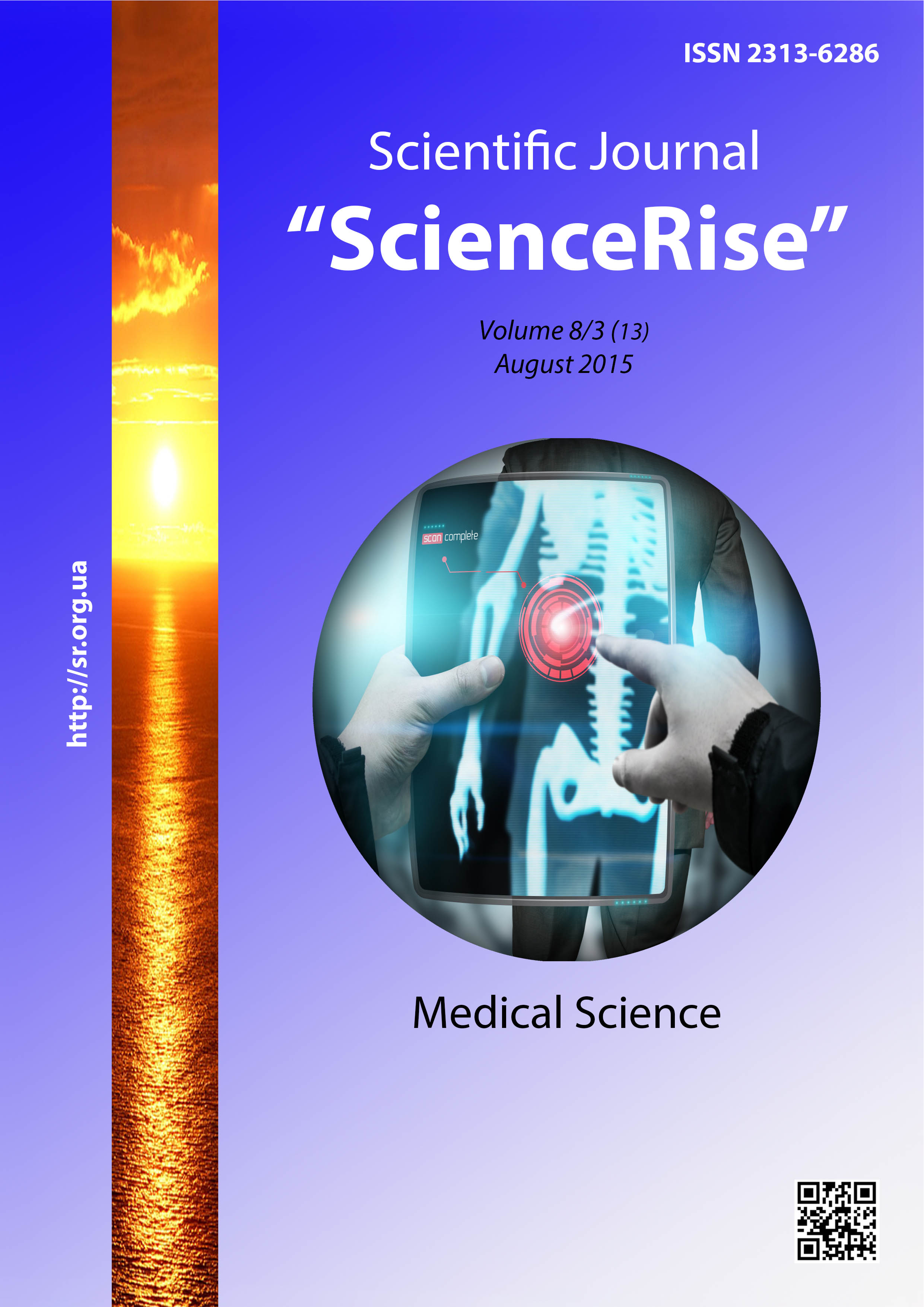Changes of self-tolerance in patients with cerebral arachnoiditis with prolonged decrease of blood pressure
DOI:
https://doi.org/10.15587/2313-8416.2015.47962Keywords:
arterial hypotension, cerebral arachnoiditis, self-tolerance, immunoglobulins, interferon, cytokines, persistenceAbstract
The work deals with the features of functional disorders of united regulative system of organism – neuro-immune-ecdocrine complex - on the background of prolonged persistence of infection in patients with neurological symptom complexes of central nervous system organic injury of inflammatory genesis.
Methods. There were examined 107 patients: 62 patients with cerebral arachnoiditis on the background of chronic nidi of infection and 45 patients of the control group with physiological arterial hypotension. There were carried out clinical and neurological examinations, monitoring of the blood pressure, determination of the state of the primary and secondary immunities.
Results. Antibodies are synthesized on the background of the prolonged persistence of infection and at the disorder of the protective functions of organism it cause the structural damages of the nervous tissue that by-turn can induce autoimmune processes that are insured by aggressive clones of T-lymphocytes with participation of inflammatory and anti-inflammatory factors.
Conclusions. In the complex of treatment it is necessary to use the differentiated therapy taking into account the individual features of heterogeneity of disorders of immunoresistance at prolonged persistence of infection in organism directed to renewal of structural and functional disorders, changes in the primary and secondary immunity link with the use of immunocorrectors, desensitizing preparations, enterosorbents, immunoglobulins, thymus hormones, nucleic acids preparations, plasmapheresis
References
Panchenko, E. N. (1978). Nervnaja patologija pri arterial'noj gipotonii [Pathology of the nervous system in arterial hypotension]. Kiev: Zdorov’ja, 156.
Potapenko, V. P. (2007). Nizkoe davlenie. Prichiny i jeffektivnoe lechenie [Low blood pressure. Reasons and effective treatment]. Moscow: AST; Sova, 94.
Koroteeva, T. V., Ermakova, N. V., Babkina, E. V., Kutenev, E. V., Li, V. A. (2011). Sutochnyj profil' arterial'nogo davlenija u zhenshhin raznyh jetnicheskih grupp s nejrocirkuljatornoj distoniej [Daily structure of blood pressure in women different ethnic groups with neurocirculatory dystonia]. Tehnologii zhivyh sistem, 3, 29–33.
Fonjakin, A. V., Atajan, A. S., Mashin, V. Vl. (2011). Sosudistye kognitivnye rasstrojstva pri idiopaticheskoj arterial'noj gipotenzii [Vascular cognitive impairment in idiopathic arterial hypotension]. Kardiovaskuljarnaja terapija i profilaktika, 4, 28–29.
Tjurina, T. V. (2008). Raspoznavanie gipotenzitivnyh sostojanij i ih korrekcija [Recognition gipotenzivnyj States and their correction]. Consilium medicum, 5, 31–34.
Haitov, R. M. (1999). Vzaimodejstvie kletok immunnoj sistemy: fiziologija i medicinskie aspekty immuniteta [The interaction of immune system cells: physiology and medical aspects of immunity]. Allergologija i klinicheskaja immunologija, 1, 6–20.
Romancov, M. G., Mel'nikova, I. Ju., Smagina, A. N., Shul'djakov, A. A. (2012). Sindrom vospalenija dyhatel'nyh putej u detej [The syndrome of inflammation of the respiratory tract in children]. Krasnodar: Prosveshhenie-Jug, 188.
Haitov, R. M., Pinegin, B. V. (1999). Vtorichnye immunodeficity: klinika, diagnostika, lechenie [Secondary immunodeficiency: clinical features, diagnosis, treatment]. Immunologija, 1, 14–17.
Sergeev, M. M., Druzhina, S. P., Red'ko, S. A. (2004). Osobennosti kliniki i rezul'taty lechenija vnutricherepnyh oto- i rinosinusogennyh oslozhnenij [The clinical features and treatment results of intracranial oto- and rhinosinusogenic complications]. Rossijskaja otorinolaringologija, 6, 31–36.
Shtok, V. N. (2000). Arahnoidit [Arachnoiditis]. Moscow: Medinform. agentstvo, 194–195.
Frejdlin, I. S., Tomoljan, A. A. (2001). Kletki immunnoj sistemy. Limfocity [The cells of the immune system. Lymphocytes]. St. Petersburg: Nauka, 197.
Sorokin, O. V., Markova, E. V., Abramov, V. V. (2005). Strukturnaja arhitektonika nejroimmunnoj sistemy [Architectonic structural of the neuroimmune system]. Nejroimmunologija, 2, 196.
Schwartz, M., London, A., Shechter, R. (2009). Boosting T-cell immunity as a therapeutic approach for neurodegenerative conditions: The role of innate immunity. Neuroscience, 158 (3), 1133–1142. doi: 10.1016/j.neuroscience.2008.12.013
Rabson, A., Rojt, A., Delvz, P. (2006). Osnovy medicinskoj immunologii [Fundamentals of medical immunology]. Moscow: Mir, 315.
Simbircev, A. S. (2004). Citokiny: klassifikacija i biologicheskie funkcii [Cytokines: classification and biological functions]. Citokiny i vospaleni, 3, 16–22.
Jarilin, A. A. (2003). Citokiny v timuse. Vyrabotka i recepcija citokinov [Cytokines in the thymus. Generation and reception of cytokines]. Citokiny i vospalenie, 1, 3–13.
Havinson, V. H., Kvetnoj, I. M., Juzhakov, V. V., Popuchiev, V. V., Konovalov, S. S. (2003). Peptidergicheskaja reguljacija gomeostaza [Peptidergic regulation of homeostasis]. St. Petersburg: Nauka, 196.
Ransohoff, R. M., Brown, M. A. (2012). Innate immunity in the central nervous system. Journal of Clinical Investigation, 122 (4), 1164–1171. doi: 10.1172/jci58644
Ul'janich, N. V. (2012). Gipotonija ili arterial'naja gipotenzija [Hypotension or hypotension]. Pchelovodstvo, 2, 48–49.
Quresh, A. I., Georgiadis, L. (2011). Texbook of Intervenntional Neurology. Cambridge University Press, 496.
Pochueva, T. V. (2006). Antigomotoksicheskie preparaty v lechenii i profilaktike ostryh srednih otitov, oslozhnennyh otogennym arahnoiditom [Anti-homotoxic preparations in the treatment and prevention of acute otitis media complicated otogenous arachnoiditis]. Zhurnal vushnih, nosovih і gorlovih hvorob, 5, 14–21.
Makarova, T. T. (1985). Cerebral arachnoiditis: (review of the literature). Vrach Delo, 2, 86–90.
Len, T. K., Neary, J. P. (2010). Cerebrovascular pathophysiology following mild traumatic brain injury. Clinical Physiology and Functional Imaging, 31 (2), 85–93. doi: 10.1111/j.1475-097x.2010.00990.x
Downloads
Published
Issue
Section
License
Copyright (c) 2015 Елена Константиновна Зинченко, Елена Михайловна Климова, Вартануш Аршавировна Флорикян

This work is licensed under a Creative Commons Attribution 4.0 International License.
Our journal abides by the Creative Commons CC BY copyright rights and permissions for open access journals.
Authors, who are published in this journal, agree to the following conditions:
1. The authors reserve the right to authorship of the work and pass the first publication right of this work to the journal under the terms of a Creative Commons CC BY, which allows others to freely distribute the published research with the obligatory reference to the authors of the original work and the first publication of the work in this journal.
2. The authors have the right to conclude separate supplement agreements that relate to non-exclusive work distribution in the form in which it has been published by the journal (for example, to upload the work to the online storage of the journal or publish it as part of a monograph), provided that the reference to the first publication of the work in this journal is included.

